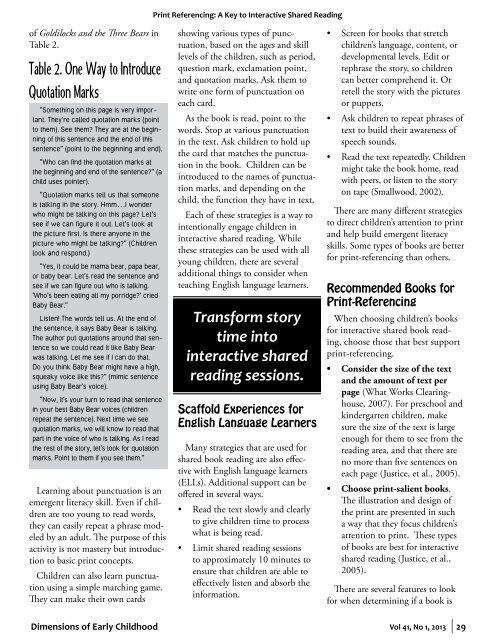Print-Referencing - Southern Early Childhood Association
Print-Referencing - Southern Early Childhood Association
Print-Referencing - Southern Early Childhood Association
Create successful ePaper yourself
Turn your PDF publications into a flip-book with our unique Google optimized e-Paper software.
<strong>Print</strong> <strong>Referencing</strong>: A Key to Interactive Shared Reading<br />
of Goldilocks and the Three Bears in<br />
Table 2.<br />
Table 2. One Way to Introduce<br />
Quotation Marks<br />
“Something on this page is very important.<br />
They’re called quotation marks (point<br />
to them). See them? They are at the beginning<br />
of this sentence and the end of this<br />
sentence” (point to the beginning and end).<br />
“Who can find the quotation marks at<br />
the beginning and end of the sentence?” (a<br />
child uses pointer).<br />
“Quotation marks tell us that someone<br />
is talking in the story. Hmm…I wonder<br />
who might be talking on this page? Let’s<br />
see if we can figure it out. Let’s look at<br />
the picture first. Is there anyone in the<br />
picture who might be talking?” (Children<br />
look and respond.)<br />
“Yes, it could be mama bear, papa bear,<br />
or baby bear. Let’s read the sentence and<br />
see if we can figure out who is talking.<br />
‘Who’s been eating all my porridge?’ cried<br />
Baby Bear.”<br />
Listen! The words tell us. At the end of<br />
the sentence, it says Baby Bear is talking.<br />
The author put quotations around that sentence<br />
so we could read it like Baby Bear<br />
was talking. Let me see if I can do that.<br />
Do you think Baby Bear might have a high,<br />
squeaky voice like this?” (mimic sentence<br />
using Baby Bear’s voice).<br />
“Now, it’s your turn to read that sentence<br />
in your best Baby Bear voices (children<br />
repeat the sentence). Next time we see<br />
quotation marks, we will know to read that<br />
part in the voice of who is talking. As I read<br />
the rest of the story, let’s look for quotation<br />
marks. Point to them if you see them.”<br />
Learning about punctuation is an<br />
emergent literacy skill. Even if children<br />
are too young to read words,<br />
they can easily repeat a phrase modeled<br />
by an adult. The purpose of this<br />
activity is not mastery but introduction<br />
to basic print concepts.<br />
Children can also learn punctuation<br />
using a simple matching game.<br />
They can make their own cards<br />
showing various types of punctuation,<br />
based on the ages and skill<br />
levels of the children, such as period,<br />
question mark, exclamation point,<br />
and quotation marks. Ask them to<br />
write one form of punctuation on<br />
each card.<br />
As the book is read, point to the<br />
words. Stop at various punctuation<br />
in the text. Ask children to hold up<br />
the card that matches the punctuation<br />
in the book. Children can be<br />
introduced to the names of punctuation<br />
marks, and depending on the<br />
child, the function they have in text.<br />
Each of these strategies is a way to<br />
intentionally engage children in<br />
interactive shared reading. While<br />
these strategies can be used with all<br />
young children, there are several<br />
additional things to consider when<br />
teaching English language learners.<br />
Transform story<br />
time into<br />
interactive shared<br />
reading sessions.<br />
Scaffold Experiences for<br />
English Language Learners<br />
Many strategies that are used for<br />
shared book reading are also effective<br />
with English language learners<br />
(ELLs). Additional support can be<br />
offered in several ways.<br />
• Read the text slowly and clearly<br />
to give children time to process<br />
what is being read.<br />
• Limit shared reading sessions<br />
to approximately 10 minutes to<br />
ensure that children are able to<br />
effectively listen and absorb the<br />
information.<br />
• Screen for books that stretch<br />
children’s language, content, or<br />
developmental levels. Edit or<br />
rephrase the story, so children<br />
can better comprehend it. Or<br />
retell the story with the pictures<br />
or puppets.<br />
• Ask children to repeat phrases of<br />
text to build their awareness of<br />
speech sounds.<br />
• Read the text repeatedly. Children<br />
might take the book home, read<br />
with peers, or listen to the story<br />
on tape (Smallwood, 2002).<br />
There are many different strategies<br />
to direct children’s attention to print<br />
and help build emergent literacy<br />
skills. Some types of books are better<br />
for print-referencing than others.<br />
Recommended Books for<br />
<strong>Print</strong>-<strong>Referencing</strong><br />
When choosing children’s books<br />
for interactive shared book reading,<br />
choose those that best support<br />
print-referencing.<br />
• Consider the size of the text<br />
and the amount of text per<br />
page (What Works Clearinghouse,<br />
2007). For preschool and<br />
kindergarten children, make<br />
sure the size of the text is large<br />
enough for them to see from the<br />
reading area, and that there are<br />
no more than five sentences on<br />
each page (Justice, et al., 2005).<br />
• Choose print-salient books.<br />
The illustration and design of<br />
the print are presented in such<br />
a way that they focus children’s<br />
attention to print. These types<br />
of books are best for interactive<br />
shared reading (Justice, et al.,<br />
2005).<br />
There are several features to look<br />
for when determining if a book is<br />
Dimensions of <strong>Early</strong> <strong>Childhood</strong> Vol 41, No 1, 2013 29
















